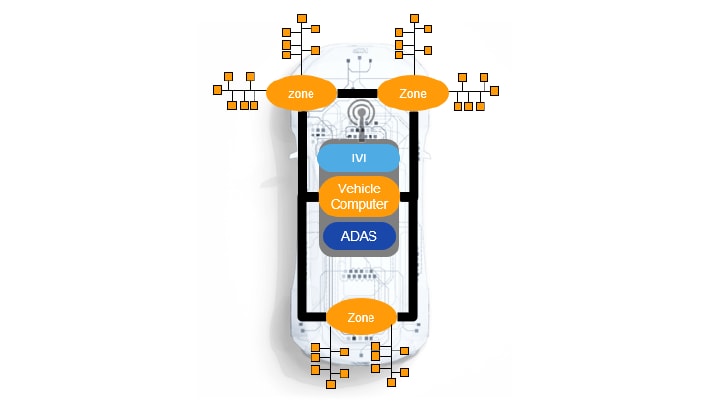The automotive industry’s move toward software-defined vehicles (SDVs) is well underway. Manufacturers and drivers
alike
are enthusiastically embracing the connectivity and upgradeability of these technologies, not the least of which is
the
ability to introduce new functionality or customization through over-the-air (OTA) software updates. Along with this
recent emergence of SDVs, vehicles have already been adding new functions like advanced driver assistance systems
(ADAS)
and push-button start for years.
All of this innovation adds to the electrical and electronic requirements of modern cars. In addition to needing more
sophisticated electronic components, they need to be integrated and interconnected so that every function can be
monitored and controlled safely.
Each component requires precise power management, and any deviation could result in failure. So, in addition to the
network of central compute systems, MCUs, Ethernet connections, sensors and actuators, there’s also an intricate
network of power distribution lines, all orchestrated through power management integrated circuits (PMICs).
PMICs from NXP tackle these
challenges head-on, offering high
efficiency, safety and flexibility. These devices
reduce
the complexity of vehicle architecture by providing scalable, integrated power management solutions through the
BYLink™ System Power
Platform. By simplifying board design and reducing the component count, NXP PMICs pave the way
for
creating more efficient and reliable SDVs.
The NXP PMIC portfolio offers invaluable support for automotive manufacturers:
Vehicles, especially EVs, need efficient power management. NXP PMICs offer high-efficiency buck converters
and
low-power
modes for diverse use cases.
Enables Standby mode to save energy when idle, optimizing wake-up and boot time.
Helps manufacturers achieve ASIL B or D standards with built-in safety mechanisms to detect issues and
customizable
safety reactions.
Supports all applications and works with MCUs and SOCs from other vendors, as well as various peripherals,
for
broader
flexibility.
The ByLink™ platform simplifies multi-PMIC architecture, enhancing design without compromising function or
safety.
Simplifies and lowers vehicle ECU costs by minimizing external components through specialized features.
Easier to deploy with one-time programming for full configurability and software reuse within a device family
for
streamlined development.
New use cases demand extended mission profile qualifications, with NXP leading the way for next-generation
vehicles.
Each of these advantages improves time to market, reduces the design complexity, and eases the functional safety
approach across the vehicle.
The E/E architecture of software-defined vehicles has evolved from using domain controllers dedicated to specific
functions like lighting or steering, which required extensive subcomponents and wiring, increasing weight and
complexity. Now, manufacturers are adopting a zonal architecture with three data and service levels. Processing is
primarily handled by a central compute system, which communicates with zone controllers near the end nodes they
serve.
Central compute systems consolidate functions from previously separate ECUs into a single unit that can be updated,
reconfigured and customized. This integration reduces vehicle complexity, cost and weight by replacing multiple
components with one powerful system.
The S32N family of vehicle super-integration processors, combined
with FS04 power management and preintegrated
software
from the S32 CoreRide platform, allows automakers to safely
integrate cross-vehicle functions within isolated
environments. However, managing power is complex and requires multiple PMICs. NXP’s ByLink™ platform synchronizes
battery-connected PMICs with one or multiple 5 V PMICs, ensuring smooth transitions, automatic power-up and
power-down
sequence, and facilitating functional safety integration.
Precise voltage control is essential, especially with memory chips that have asymmetric thresholds. NXP’s FS04 PMICs use
analog-to-digital converters for improved accuracy while meeting ASIL D safety standards. The S32N cores are powered
by
the PF53 POL regulator, providing high power with optimized
material costs.
Zone controllers act as bridges between the central compute system, relaying information between sensors and end
nodes.
For example, a sensor at the rear of the vehicle communicates data that is used by a component near the front end.
The
power requirements are complex, requiring separate power for each transceiver and the MCU, all with varying voltage
and
current needs. NXP PMICs, like the FS26, address this with
integrated Buck and LDO regulators. Manufacturers can
also
customize output voltage, current rates and slew rates with one-time programming, offering flexibility to meet the
needs of various ECUs and processors.
A vehicle’s end nodes are the actuators, sensors and ECUs at the edge of the E/E architecture. They require less
power
than central compute or zone controllers, so NXP developed cost-optimized PMICs, including the FS23, with integrated
CAN
and/or LIN transceivers. Scalability and programmability remain crucial as manufacturers aim for a platform
approach,
reusing PMICs and program code across various use cases. NXP PMICs offer scalable options in power handling and
functional safety, with each family sharing the same package pinout. Once a PMIC is deployed, deploying others from
the
same family is much simpler, supporting platform scalability.

The shift to software-defined vehicles is reframing the driving experience for drivers and making it possible for
manufacturers to achieve new levels of efficiency and differentiation. Power management is crucial, presenting
opportunities for innovation and optimization. NXP PMICs ensure high performance by managing multiple power modes
for
maximum energy efficiency. Built around functional safety, these components feature optimized quiescent current and
fast
MCU boot sequences aligned with NXP’s SafeAssure program. NXP
PMICs enhance power performance across vehicles, from
central compute to end nodes. Scalable, reliable and efficient, they simplify systems, shorten time to market, and
support the development of software-defined vehicles.